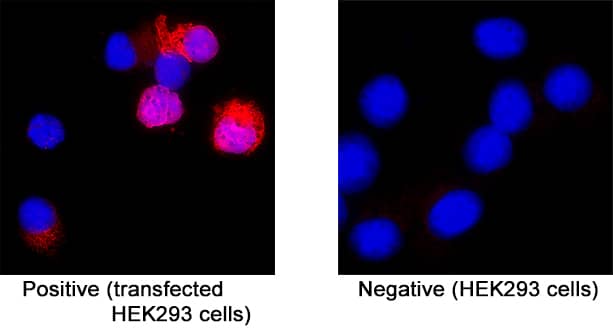SARS-CoV-2 NSP1 Antibody
R&D Systems, part of Bio-Techne | Catalog # MAB10980

Key Product Details
Species Reactivity
SARS-CoV-2
Applications
ELISA, Immunocytochemistry, Immunohistochemistry, Simple Western
Label
Unconjugated
Antibody Source
Monoclonal Mouse IgG1 Clone # 1045410
Product Specifications
Immunogen
E. coli-derived Sars-CoV-2 NSP1 protein
Met1-Gly180
Accession # YP_009725297.1
Met1-Gly180
Accession # YP_009725297.1
Specificity
Detects Sars-CoV-2 NSP1 protein in ELISA.
Clonality
Monoclonal
Host
Mouse
Isotype
IgG1
Scientific Data Images for SARS-CoV-2 NSP1 Antibody
NSP1 in HEK293 Human Cell Line Transfected with SARS-CoV-2.
NSP1 was detected in immersion fixed HEK293 human embryonic kidney cell line transfected with SARS-CoV-2 (positive staining) and HEK293 human embryonic kidney cell line (non-transfected, negative staining) using Mouse Anti-SARS-CoV-2 NSP1 Monoclonal Antibody (Catalog # MAB10980) at 8 µg/mL for 3 hours at room temperature. Cells were stained using the NorthernLights™ 557-conjugated Anti-Mouse IgG Secondary Antibody (red; Catalog # NL007) and counterstained with DAPI (blue). Specific staining was localized to cytoplasm. View our protocol for Fluorescent ICC Staining of Cells on Coverslips.NSP1 in SARS-CoV-2 infected human lung.
NSP1 was detected in immersion fixed paraffin-embedded sections of SARS-CoV-2 infected human lung using Mouse Anti-SARS-CoV-2 NSP1 Monoclonal Antibody (Catalog # MAB10980) at 5 µg/mL for 1 hour at room temperature followed by incubation with the Anti-Mouse IgG VisUCyte™ HRP Polymer Antibody (Catalog # VC001). Before incubation with the primary antibody, tissue was subjected to heat-induced epitope retrieval using Antigen Retrieval Reagent-Basic (Catalog # CTS013). Tissue was stained using DAB (brown) and counterstained with hematoxylin (blue). Specific staining was localized to immunoreactive profiles scattered throughout the tissue. View our protocol for IHC Staining with VisUCyte HRP Polymer Detection Reagents.Detection of SARS-CoV-2 NSP1 by Simple WesternTM.
Simple Western lane view shows recombinant SARS-CoV-2 Nsp1, loaded at 0.2 mg/mL. A specific band was detected for NSP1 at approximately 28 kDa (as indicated) using 20 µg/mL of Mouse Anti-SARS-CoV-2 NSP1 Monoclonal Antibody (Catalog # MAB10980) . This experiment was conducted under reducing conditions and using the 12-230 kDa separation system.Applications for SARS-CoV-2 NSP1 Antibody
Application
Recommended Usage
ELISA
This antibody functions as an ELISA capture antibody when paired with Mouse Anti-SARS-CoV-2 NSP1 Monoclonal Antibody (Catalog # MAB10991).
This product is intended for assay development on various assay platforms requiring antibody pairs.
Immunocytochemistry
8-25 µg/mL
Sample: Immersion fixed HEK293 human embryonic kidney cell line transfected with SARS-CoV-2
Sample: Immersion fixed HEK293 human embryonic kidney cell line transfected with SARS-CoV-2
Immunohistochemistry
5-25 µg/mL
Sample: Immersion fixed paraffin-embedded sections of SARS-CoV-2 infected human lung
Sample: Immersion fixed paraffin-embedded sections of SARS-CoV-2 infected human lung
Simple Western
20 µg/mL
Sample: Recombinant SARS-CoV-2 Nsp1
Sample: Recombinant SARS-CoV-2 Nsp1
Formulation, Preparation, and Storage
Purification
Protein A or G purified from hybridoma culture supernatant
Reconstitution
Reconstitute at 0.5 mg/mL in sterile PBS. For liquid material, refer to CoA for concentration.
Formulation
Lyophilized from a 0.2 μm filtered solution in PBS with Trehalose. *Small pack size (SP) is supplied either lyophilized or as a 0.2 µm filtered solution in PBS.
Shipping
Lyophilized product is shipped at ambient temperature. Liquid small pack size (-SP) is shipped with polar packs. Upon receipt, store immediately at the temperature recommended below.
Stability & Storage
Use a manual defrost freezer and avoid repeated freeze-thaw cycles.
- 12 months from date of receipt, -20 to -70 °C as supplied.
- 1 month, 2 to 8 °C under sterile conditions after reconstitution.
- 6 months, -20 to -70 °C under sterile conditions after reconstitution.
Background: NSP1
References
- Snijder, E.J. et al. (2016) Adv. Virus Res 96:59.
- Thoms, M. et al. (2020) Science 369:1249.
- Schubert, K. et al. (2020) Nat. Struct. Mol. Biol. 27:959.
- Narayanan, K. et al. (2008) J. Virol. 82:4471.
- Jauregui, A.R. et al. (2013) PLoS One. 8:e62416.
- Kamitani, W. et al. (2006) Proc. Natl. Acad. Sci. USA 103:12885.
- Huang, C. et al. (2011) PLoS Pathog. 7:e1002433.
- Hartenian, E. et al. (2020) J. Biol. Chem. 295:12910.
- Zust, R. et al. (2007) PLoS Pathog. 3:e109.
- De Lima Menezes, G. and R.A. da Silva (2020) J. Biomol. Struct. Dyn. (In press).
Long Name
Non-Structural Protein 1
UniProt
Additional NSP1 Products
Product Documents for SARS-CoV-2 NSP1 Antibody
Product Specific Notices for SARS-CoV-2 NSP1 Antibody
For research use only
